Optimization and Experimental Study of the Semi-Closed Short-Gap Arc-Extinguishing Chamber Based on a Magnetohydrodynamics Model
Abstract
:1. Introduction
2. Magnetohydrodynamics Model of Arc in Semi-Closed Short-Gap Arc-Extinguishing Chamber
2.1. Assumptions
- (1)
- The plasma is fully ionized (a two-component mixture, that is, electrons and ions).
- (2)
- The plasma is under local thermodynamic equilibrium (LTE) conditions.
- (3)
- The plasma is considered to be a locally neutral Newtonian fluid mixture.
- (4)
- The plasma flow is laminar and quasi-incompressible (low Mach number, which means that the Mach number is less than 0.3).
- (5)
- Viscous dissipation and pressure work are neglected in the energy equation.
- (6)
- The displacement current is negligible (quasi-static approximation, that is, low frequencies).
- (7)
- Magnetic diffusion dominates induction by fluid motion (Rem << 1).
- (8)
- The plasma is optically thin.
2.2. Governing Equations
2.3. Simulation Domain and Boundary Conditions
2.4. Simulation Results and Analysis
3. Optimization Method of SSAC
4. Experimental Verifications
4.1. Case Study
4.2. Results Discussion
5. Conclusions
- (1)
- Short-gap arcs form a high-speed airflow in a single chamber of the arc-extinguishing structure. The arc root moves rapidly at the junction of the electrode and the insulation wall, and arc plasma sprays to the outlet until the arc is extinguished when the current crosses zero.
- (2)
- The radius (R), electrode-electrode spacing (d1) and opening diameter (d2) of SSAC have significant effects on the airflow distribution in the chamber. Appropriate reduction of R, d1 and d2 can significantly improve the airflow velocity in the chamber. The nozzle length (d3) has little effect on the airflow distribution in the chamber.
- (3)
- When the current is constant, the greater the velocity of generated airflow in SSAC is more conducive to the extinction of the arc. A multi-stage converging-diverging structure on the SSAC nozzle is proposed and designed, the airflow velocity in the chamber can be accelerated in the converging-diverging structure, which effectively improves the airflow velocity in the arc-extinguishing chamber. The airflow velocity in the optimized structure can be increased to about 8 times that of the the basic structure.
- (4)
- Experiments show that the arc dissipation time in the optimized structure is 79.2 μs, which is significantly less than that in the basic structure (422.4 μs). This shows that the multi-stage converging-diverging structure is beneficial to the dissipation and extinction of arcs, and proves the feasibility of the structure optimization. The multi-stage converging-diverging structure proposed in this paper can be used to optimize the structure of multi-chamber arc-extinguishing structures and improve thei arc-extinguishing performance.
Author Contributions
Funding
Conflicts of Interest
References
- He, J.L.; Gu, S.Q.; Chen, S.M.; Zeng, R.; Chen, W. Discussion on measures against lightning breakage of covered conductors on distribution lines. IEEE Trans. Power Deliv. 2008, 23, 693–702. [Google Scholar]
- Chen, W.; Sun, Z.; Li, G.; Cui, J.L.; Feng, J.L.; Tang, S.Y.; Li, M.G.; Yu, J.L.; Liao, F.W.; Bao, J.Q. Development of parallel gap lightning protection device for 110 kV and 220 kV overhead lines. Power Syst. Technol. 2006, 30, 70–75. [Google Scholar]
- Lee, R.E.; Fritz, D.E.; Stiller, P.H.; Shankle, D.F. Prevention of Covered Conductor Burndown on Distribution Circuits-Arcing Protection Devices. IEEE Power Eng. Rev. 2010, 2, 18–19. [Google Scholar]
- Chino, T.; Iwata, M.; Imoto, S.; Nakayama, M.; Sakamoto, H.; Matsushita, R. Development of arcing horn device for interrupting ground-fault current of 77 kV overhead lines. IEEE Trans. Power Deliv. 2005, 20, 2570–2575. [Google Scholar] [CrossRef]
- Hashimoto, Y.; Fukui, H.; Yano, T.; Tsukazaki, M.; Sakakiwara, M. Development of Current Limiting Arcing Horn (MOV type arrester with external gap) for 22 kV power distribution line. In Proceedings of the IEEE Asia-Pacific International Conference on Lightning, Chengdu, China, 1–4 November 2011; pp. 36–39. [Google Scholar]
- Podporkin, G.V.; Enkin, E.Y.; Kalakutsky, E.S.; Pilshikov, V.E.; Sivaev, A.D. Overhead lines lightning protection by multi-chamber arresters and insulator-arresters. IEEE Trans. Power Deliv. 2011, 26, 214–221. [Google Scholar] [CrossRef]
- Podporkin, G.V.; Enkin, E.Y.; Pilshikov, V.E. The development of multichamber arresters. Russ. Electr. Eng. 2013, 84, 1–5. [Google Scholar] [CrossRef]
- Guo, T.; Zhou, W.; Su, Z.; Li, H.; Yu, J. A Multigap Structure for Power Frequency Arc Quenching in 10-kV Systems. IEEE Trans. Plasma Sci. 2016, 44, 2622–2631. [Google Scholar] [CrossRef]
- Swierczynski, B.; Gonzalea, J.J.; Teulet, P.; Freton, P.; Gleizes, A. Advances in low voltage circuit breaker modelling. J. Phys. D Appl. Phys. 2004, 37, 595–609. [Google Scholar] [CrossRef]
- Wang, Z.; He, J.; Zou, J. Power Switch Technology; Huazhong University of Science and Technology Press: Wuhan, China, 2003; pp. 179–193. ISBN 9787560930251. [Google Scholar]
- Giere, S.; Karner, P.H.C. Dielectric strength of double and single-break vacuum interrupters. IEEE Trans. Dielectr. Electr. Insul. 2001, 8, 43–47. [Google Scholar] [CrossRef]
- Tseng, K.J.; Wang, Y. Development of a Dynamic Model of Electric Arc for Power Electronics Simulations. IEEE Conf. Ind. Appl. 1996, 4, 2173–2180. [Google Scholar]
- Mokhtari, H.; Hejri, M. A New Three Phase Time-domain Model for Electric Arc Furnaces Using MATLAB. IEEE Conf. Transm. Distrib. 2002, 3, 2078–2083. [Google Scholar]
- Vander sluis, L.; Rutgers, W.R.; Koreman, C.G.A. A Physical Arc Model for the Simulation of Current Zero Behavior of High-voltage Circuit Breakers. IEEE Trans. Power Deliv. 1992, 7, 1016–1022. [Google Scholar] [CrossRef]
- Habedank, U. On the Mathematical Description of Arc Behavior in the Vicinity of Current Zero. Etz Arch. 1988, 10, 339–343. [Google Scholar]
- Schavemaker, P.H.; Vander Sluis, L. An Improved Mayr-type Arc Model Based on Current-zero Measurements. IEEE Trans. Power Deliv. 2000, 15, 580–584. [Google Scholar] [CrossRef]
- Schavemaker, P.H. Arc Model Blockset. In Proceedings of the Second IASTED International Conference Power and Energy Systems (EuroPES), Crete, Greece, 25–28 June 2002. [Google Scholar]
- Smeets, R.P.P.; Kertesz, V. Evaluation of High-voltage Circuit Breaker Performance Witha Validated Arc Model. IEEE Proc. Gener. Transm. Distrib. 2000, 147, 121–125. [Google Scholar] [CrossRef]
- Lowke, J.J.; Kovitya, P.; Schmidt, H.P. Theory of free-burning arc columns including the influence of the cathode. J. Phys. D Appl. Phys. 1992, 25, 1600. [Google Scholar] [CrossRef]
- Horinouchi, K.; Nakayama, Y.; Hidaka, M.; Yonezawa, T.; Sasao, H. A method of simulating magnetically driven arcs. IEEE Trans. Power Deliv. 1997, 12, 213–218. [Google Scholar] [CrossRef]
- Zhainakow, A. Three-dimensional Mathematical Model for the Calculation of Electric-arc Plasma Flows. High Temp. 2002, 40, 9–14. [Google Scholar] [CrossRef]
- Wu, Y.; Rong, M.; Li, X.; Murphy, A.B.; Wang, X.; Yang, F.; Sun, Z. Numerical Analysis of the Effect of the Chamber Width and Outlet Area on the Motion of an Air Arc Plasma. IEEE Trans. Plasmaence 2008, 36, 2831–2837. [Google Scholar]
- Chadebec, O.; Meunier, G.; Mazauric, V.G.; Le Floch, Y.; Labie, P. Eddy-current effects in circuit breakers during arc displacement phase. IEEE Trans. Magn. 2008, 40, 1358–1361. [Google Scholar] [CrossRef]
- Wu, Y.; Rong, M.; Sun, Z.; Wang, X.; Yang, F.; Li, X. Numerical analysis of arc plasma behaviour during contact opening process in low-voltage switching device. J. Phys. D Appl. Phys. 2007, 40, 795–802. [Google Scholar] [CrossRef]
- Freton, P.; Gonzalez, J.J.; Ranarijaona, Z.; Mougenot, J. Energy equation formulations for two-temperature modelling of ‘thermal’ plasmas. J. Phys. D Appl. Phys. 2012, 45, 465206. [Google Scholar] [CrossRef]
- Wu, Y.; Li, M.; Rong, M.; Yang, F.; Murphy, A.B.; Wu, Y.; Yuan, D. Experimental and theoretical study of internal fault arc in a closed container. J. Phys. D Appl. Phys. 2014, 47, 505204. [Google Scholar] [CrossRef]
- Zhang, J.L.; Yan, J.D.; Murphy, A.B.; Hall, W.; Fang, M.T. Computational investigation of arc behavior in an auto-expansion circuit breaker contaminated by ablated nozzle vapor. IEEE Trans. Plasma Sci. 2002, 30, 706–719. [Google Scholar] [CrossRef]
- Zhang, J.L.; Yan, J.D.; Fang, M.T.C. Investigation of the effects of pressure ratios on arc behavior in a supersonic nozzle. IEEE Trans. Plasma Sci. 2000, 28, 1725–1734. [Google Scholar] [CrossRef]
- Yos, J. Revised transport properties for high temperature air and its components. AVCO Space Syst. Div. Tech. Release 1967, 16, 10014936914. [Google Scholar]
- Lei, Z.S.; Garimella, S.V.; Chan, S.H. Gas dynamics and electromagnetic processes in high-current arc plasmas. Part II. Effects of external magnetic fields and gassing materials. J. Appl. Phys. 1999, 85, 2547–2555. [Google Scholar]
- Freton, P.; Gonzalez, J.J.; Gleizes, A. Comparison between a two- and a three-dimensional arc plasma configuration. J. Phys. D Appl. Phys. 2000, 33, 2442–2452. [Google Scholar] [CrossRef]
- Lowke, J.J.; Morrow, R.; Haidar, J. A simplified unified theory of arcs and their electrodes. J. Phys. D Appl. Phys. 1997, 7, 2033–2042. [Google Scholar] [CrossRef]
- Liu, Y.J.; Chang, G.W.; Huang, H.M. Mayr’s equation-based model for Pantograph Arc of high-speed railway traction system. IEEE Trans. Power Deliv. 2010, 25, 2025–2027. [Google Scholar] [CrossRef]
- Nakagawa, T.; Nakiri, T.; Hosoya, R.; Tajitsu, Y. Electrical properties of biodegradable polylactic acid film. IEEE Trans. Ind. Appl. 2003, 40, 1020–1024. [Google Scholar] [CrossRef]
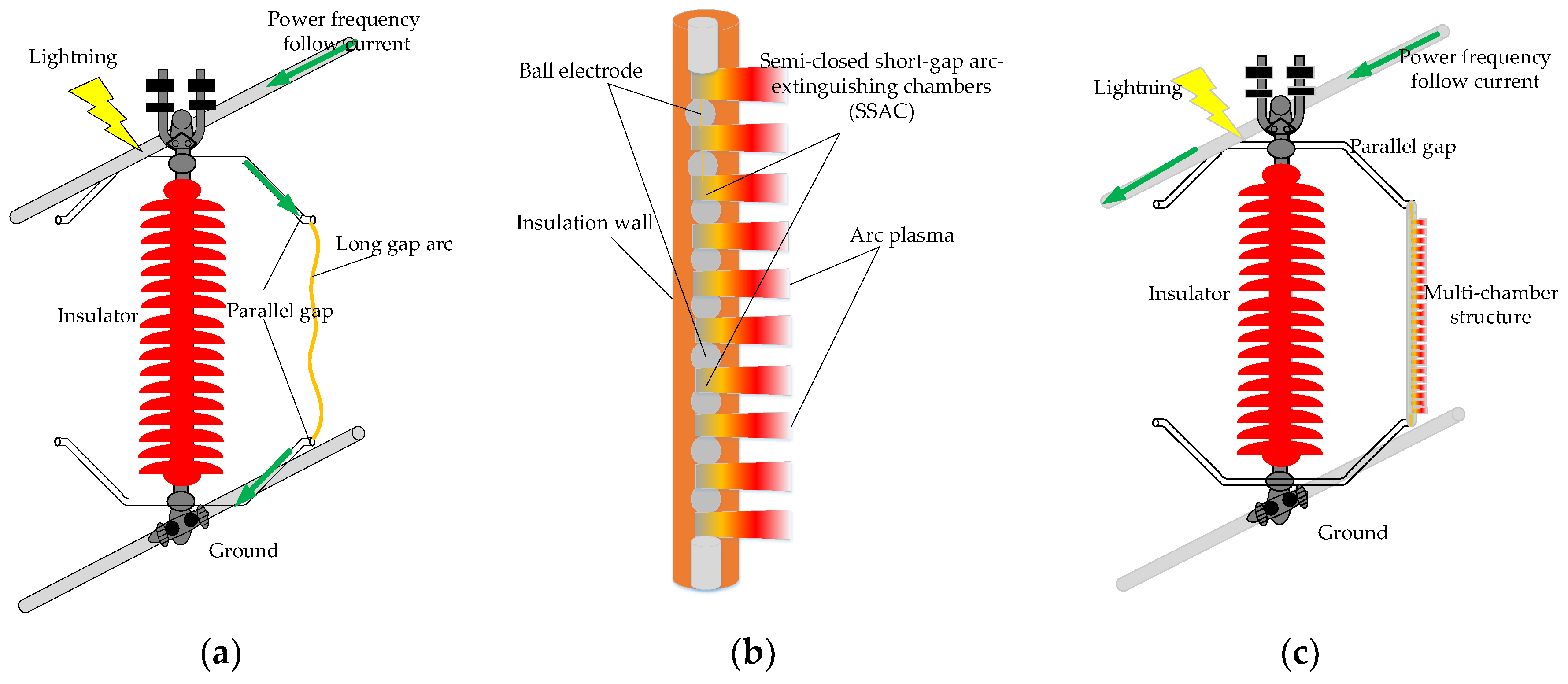
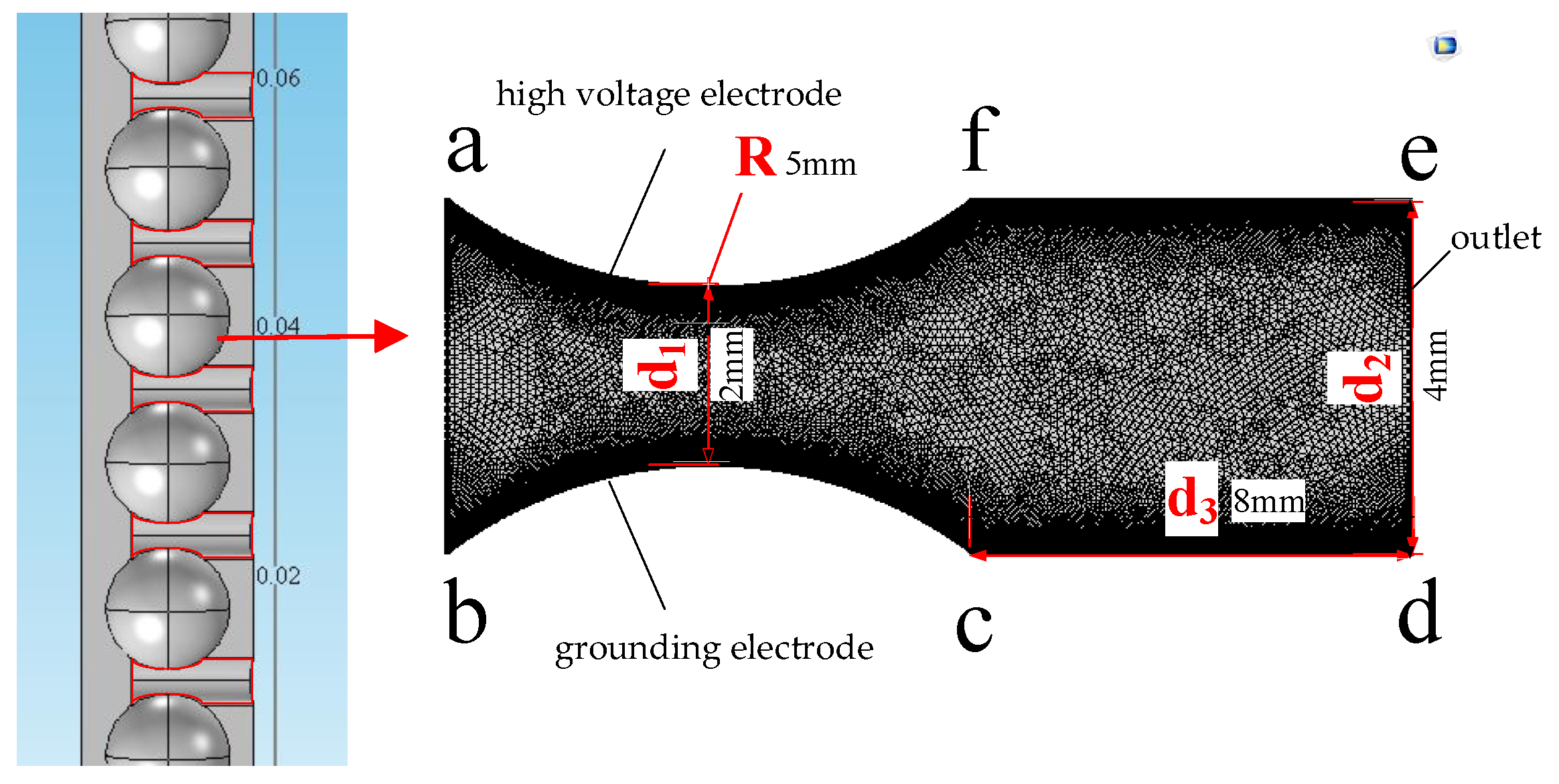

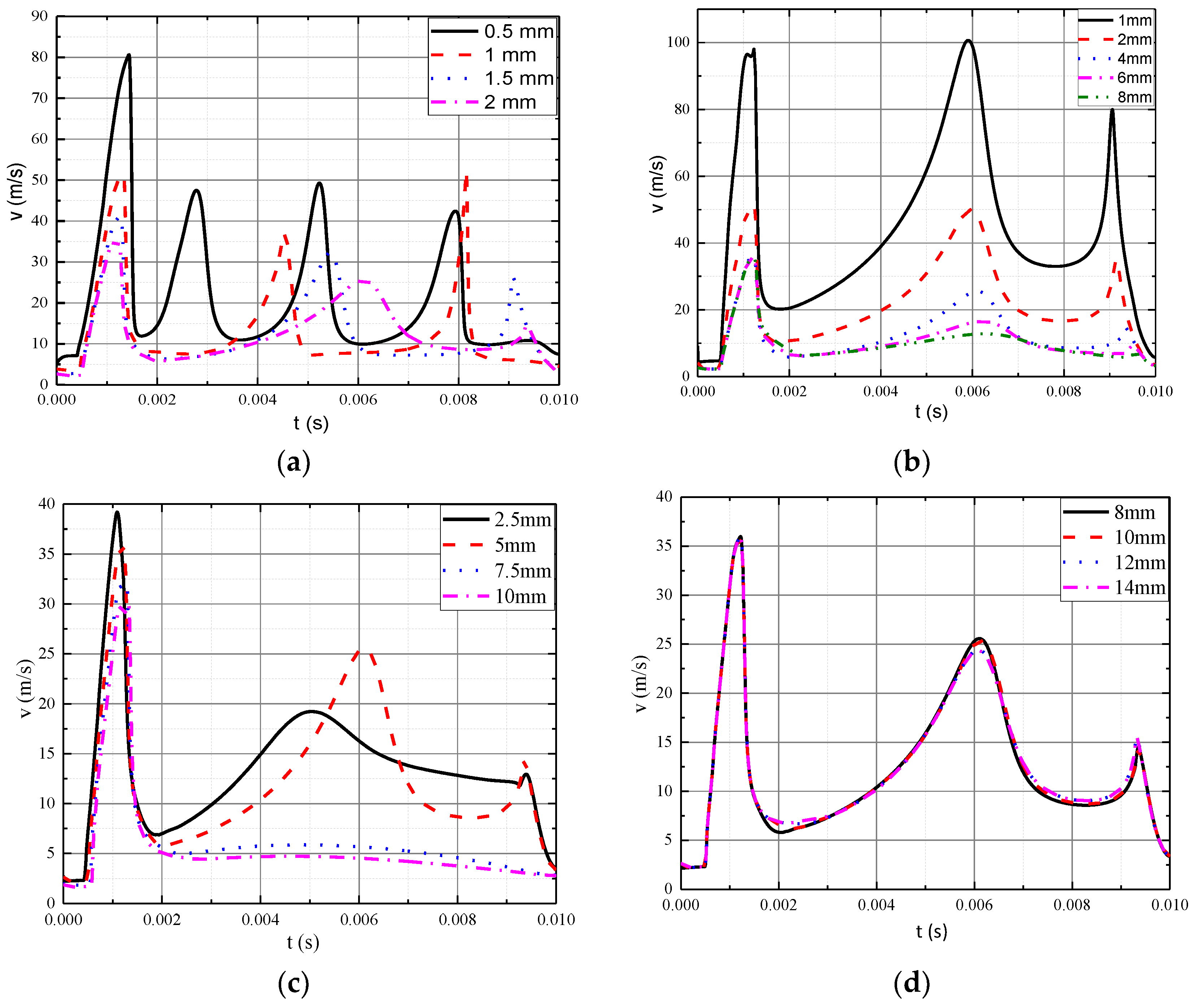

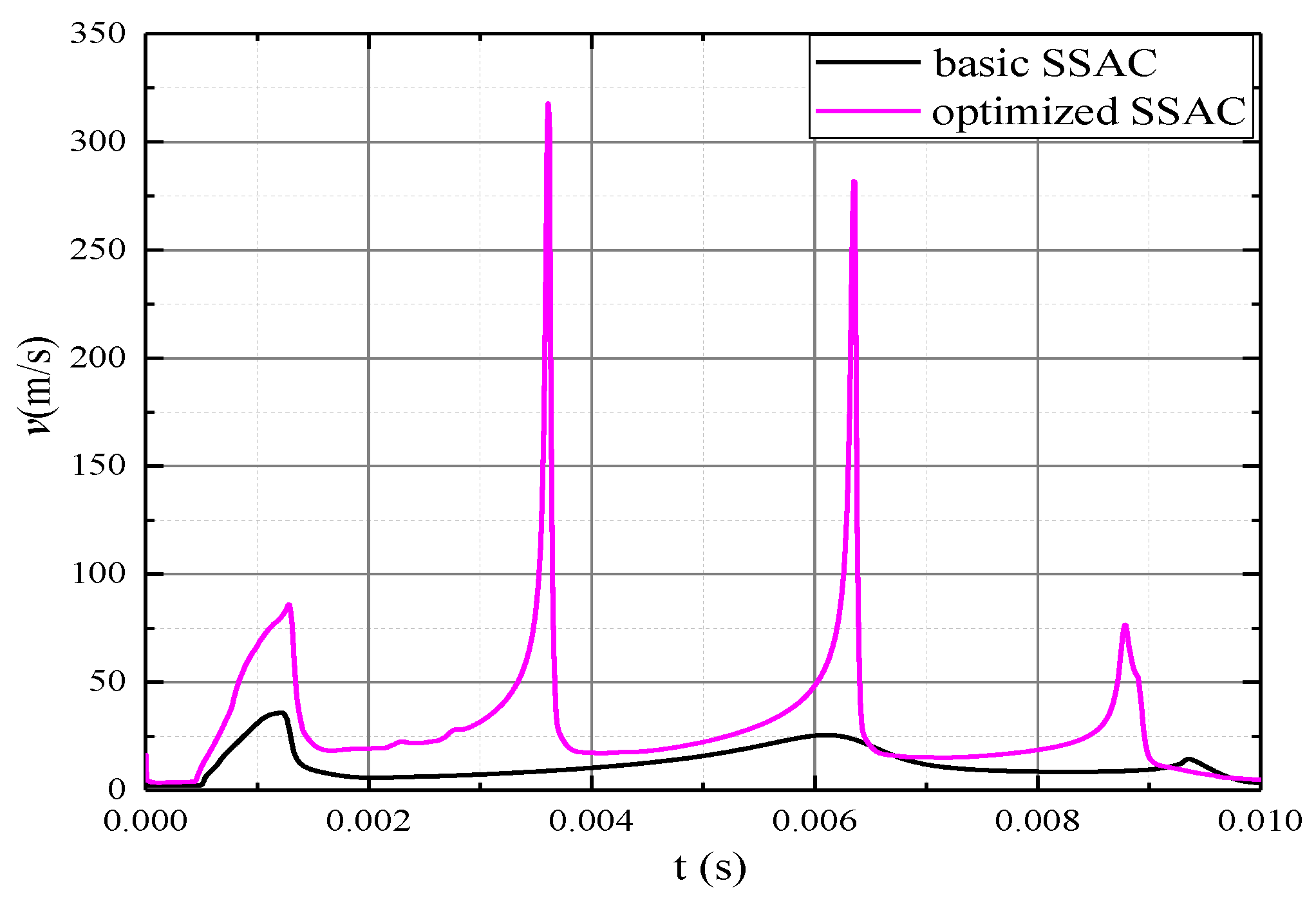

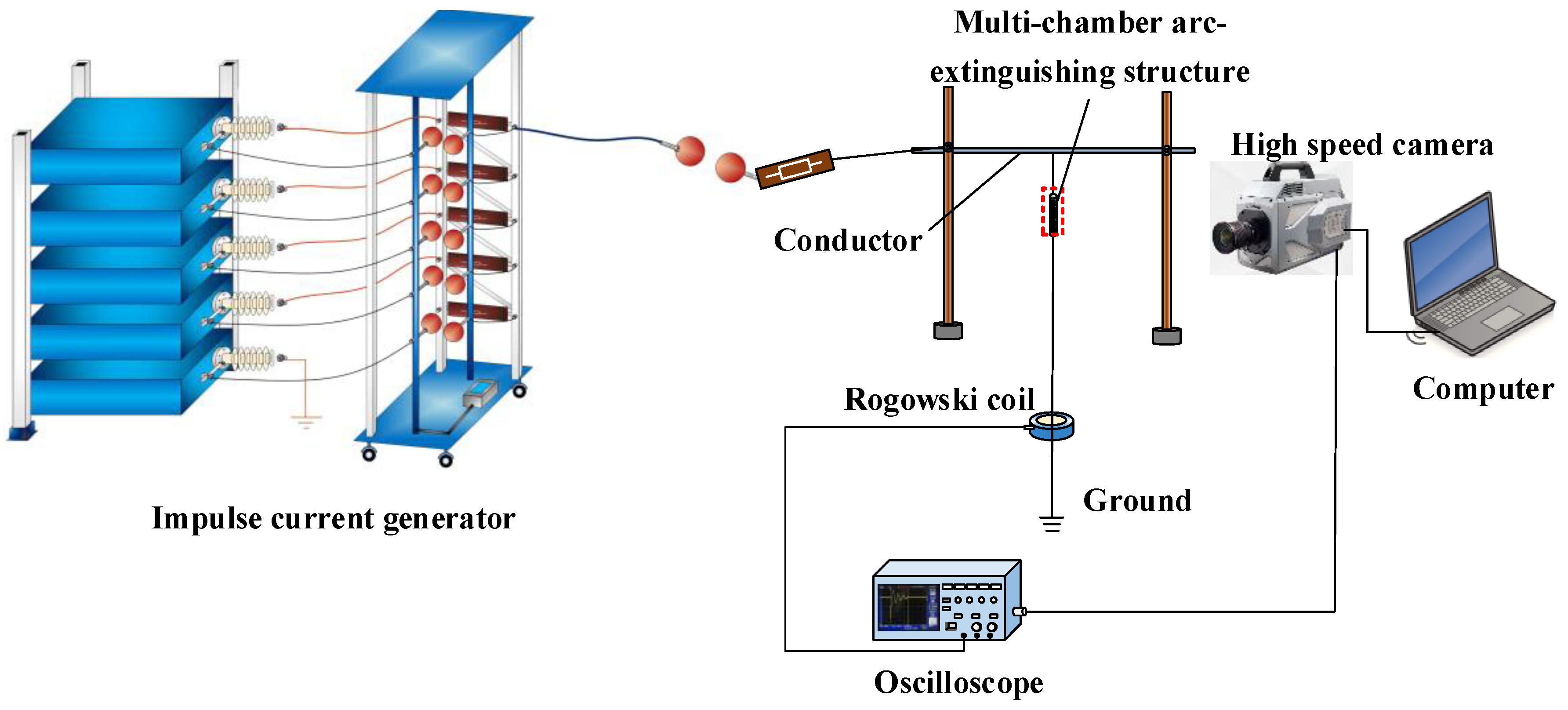

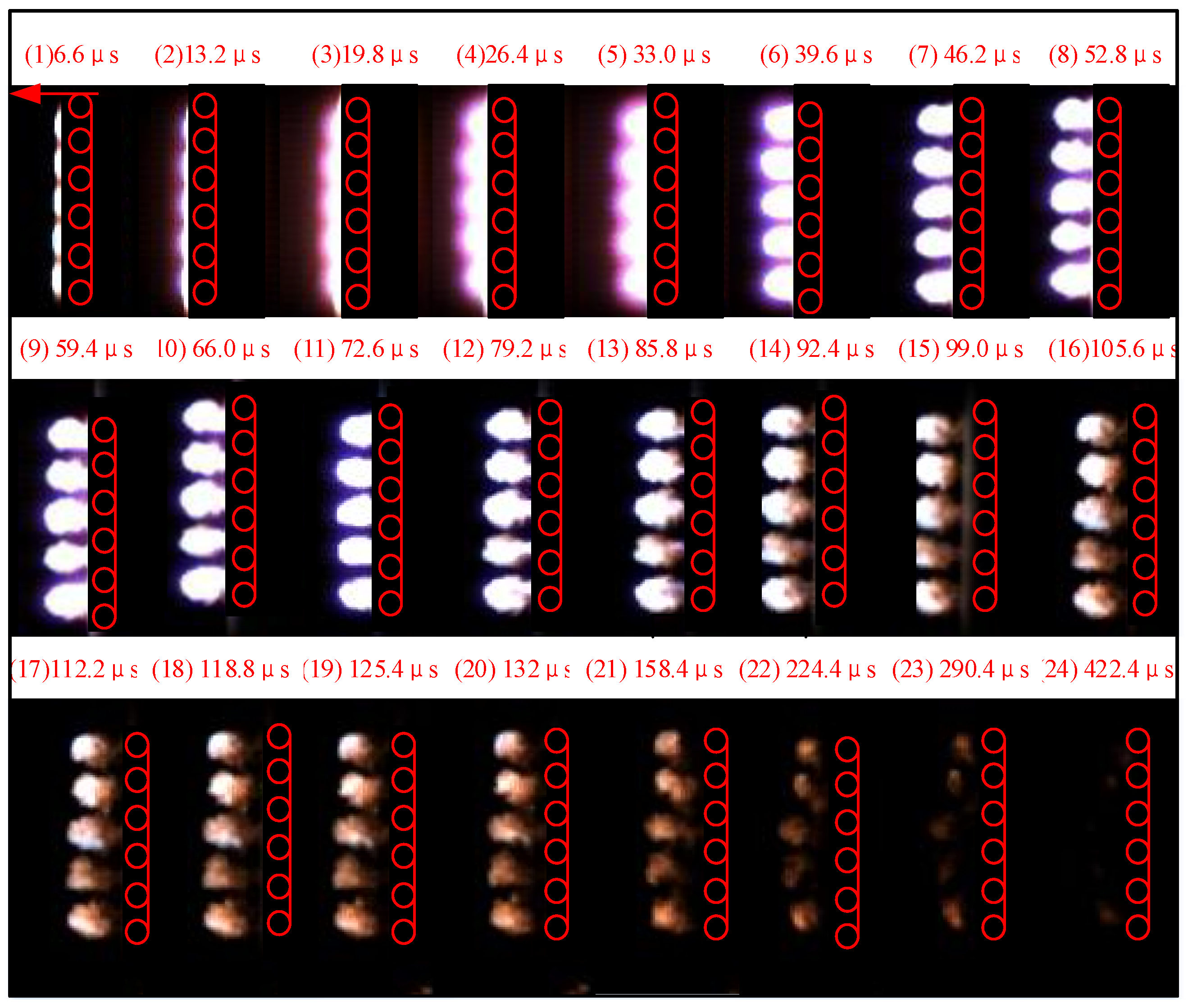
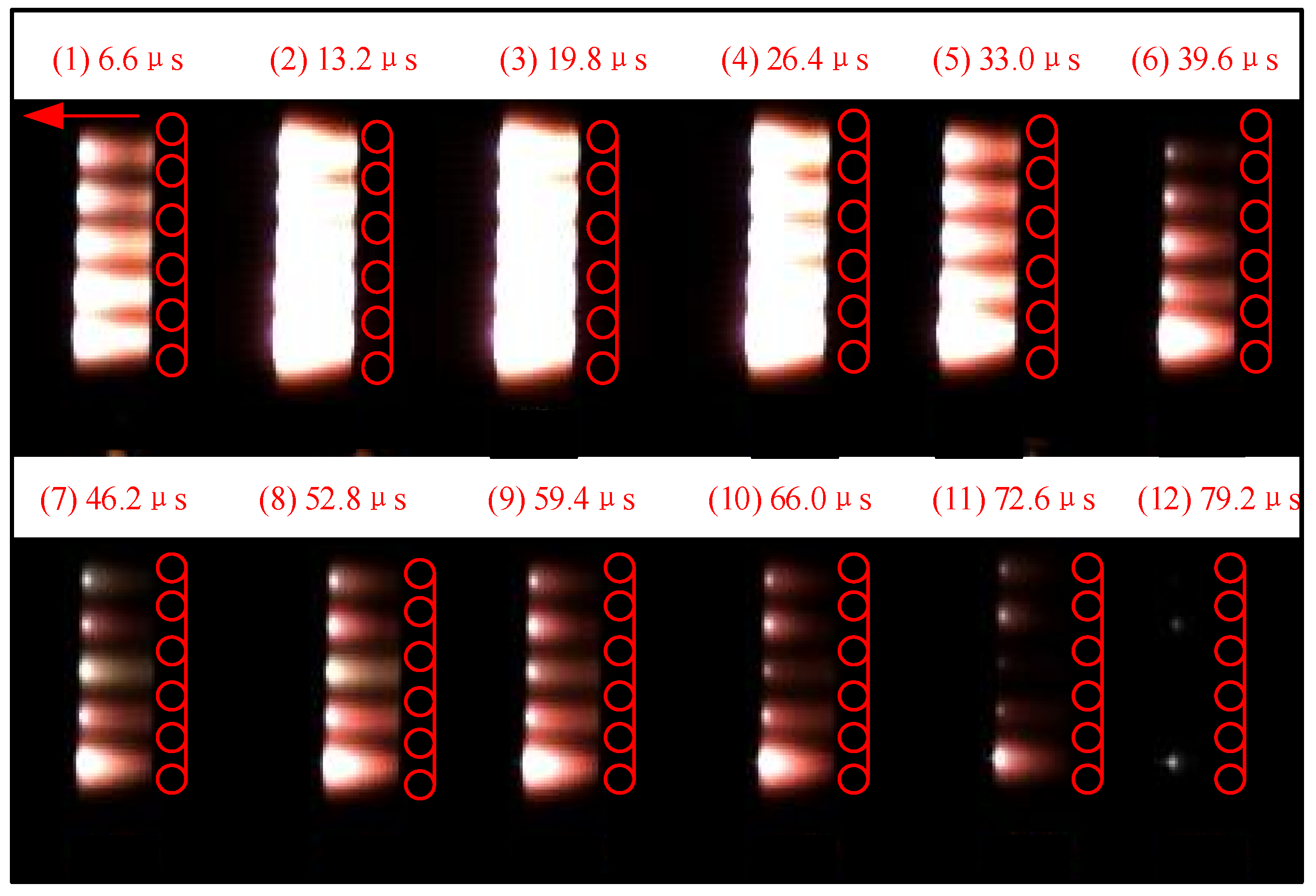
© 2018 by the authors. Licensee MDPI, Basel, Switzerland. This article is an open access article distributed under the terms and conditions of the Creative Commons Attribution (CC BY) license (http://creativecommons.org/licenses/by/4.0/).
Share and Cite
Jia, W.; Sima, W.; Yuan, T.; Yang, M.; Sun, P. Optimization and Experimental Study of the Semi-Closed Short-Gap Arc-Extinguishing Chamber Based on a Magnetohydrodynamics Model. Energies 2018, 11, 3335. https://doi.org/10.3390/en11123335
Jia W, Sima W, Yuan T, Yang M, Sun P. Optimization and Experimental Study of the Semi-Closed Short-Gap Arc-Extinguishing Chamber Based on a Magnetohydrodynamics Model. Energies. 2018; 11(12):3335. https://doi.org/10.3390/en11123335
Chicago/Turabian StyleJia, Wenbin, Wenxia Sima, Tao Yuan, Ming Yang, and Potao Sun. 2018. "Optimization and Experimental Study of the Semi-Closed Short-Gap Arc-Extinguishing Chamber Based on a Magnetohydrodynamics Model" Energies 11, no. 12: 3335. https://doi.org/10.3390/en11123335
APA StyleJia, W., Sima, W., Yuan, T., Yang, M., & Sun, P. (2018). Optimization and Experimental Study of the Semi-Closed Short-Gap Arc-Extinguishing Chamber Based on a Magnetohydrodynamics Model. Energies, 11(12), 3335. https://doi.org/10.3390/en11123335



